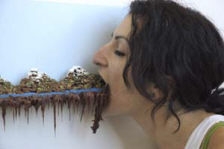Feature: Reviews
Bessma Khalaf: This Land is My Land
- San Francisco Art Commission Gallery
- San Francisco
Bessma Khalaf’s This Land is My Land (2005) seems delightfully simple at first. A flat screen in a gallery box plays a looped video, without sound, of Khalaf appearing to eat a cross section of landscape made largely of chocolate and colored sugar. The shot is framed in the simplest way possible; the “land” forms a midline moving across the screen, mountains above, stalactites below, and Khalaf’s disembodied head, like a living Pac Man, jaws away at it. As she chews, more land files dutifully into her mouth, no hands involved. This is physically possible because a wall, which is painted with a subtle sky blue above the horizon, but otherwise bare, supports the land and makes the shot flat and intimate. The tiny landscape is exquisitely detailed, and the chewing motion is superficially hypnotic. As a composition, the piece is deceptively stable.
The first noticeably complicated element of the performance is the fact that Khalaf is not actually eating the “land,” but laboriously chewing it up and spitting it out, the chocolate frosting now turd-like as it disappears from the frame, at sporadic intervals. A residue of dark brown slime accumulates around her mouth and on her cheeks as her breathing becomes heavier, and at times she rests her head against the wall from the joyless effort of masticating so much elaborately decorated dessert. Sometimes she drops whole chunks of broken landscape almost completely unchewed.
And at once the multiplicity of significance becomes obvious. The terrain becomes recognizable as the American landscape. The mountains are the Rocky Mountains. That peanut-butter and graham cracker erosional remnant is from postcards and calendars advertising vacations in Arizona. Model-train nostalgia confronts monster-movie anxiety, and is consumed and yet fueled by a bulimic’s ambivalence. The food looks as good as Little Debby snack cakes, but also recalls the romantic landscape paintings of Hudson River School forefather Thomas Cole. And like Cole, who criticized Manifest Destiny’s exploitation of the American environment while simultaneously depicting its seductive beauty, Kalaf has captured a contradiction. Decadence is so disgusting because it’s too sweet, too good, too much. The literal consumption of the landmass relates closely to Cole’s warning about the loss of pastoral ways of life, while the oily shit coming out of Khalaf’s mouth suggests the non-renewable basis of current American consumer culture. And on top of this, she herself is Iraqi-American during a time of unprecedented angst about the role of Middle Eastern oil in global economics, America’s oil consumption firmly entrenched at the heart of a seemingly interminable war. The role and status of women in both Middle Eastern and Western cultures (and the Western woman’s relationship to food) pose more tangential questions.
The apparent simplicity of the piece thus gives way to a flood of associations and references. Framing it as a video installation without sound allows the references to painting to come to the fore, and video plays an integral part in the success of the piece, forcing the viewer to contemplate both the craftsmanship of the dessert and the grotesque action imposed upon it.
Bessma Khalaf’s video This Land is My Land was on view at the San Francisco Art Commission Gallery this fall as part of Immediate Futures: The 2006 Murphy & Cadogan Fellowships in the Fine Arts.

